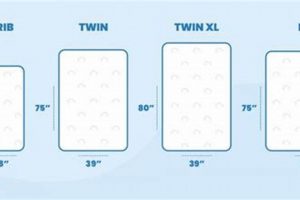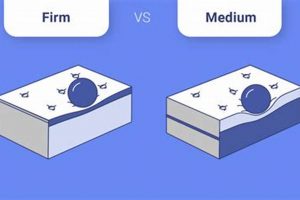A comparison of mattress sizes often involves contrasting the dimensions of a larger bed option with a smaller one, focusing on width and length. For example, one common comparison examines a mattress measuring approximately 54 inches wide by 75 inches long alongside another measuring approximately 39 inches wide by 75 inches long. This dimensional disparity significantly impacts the suitability of each size for different users and room sizes.
The selection of an appropriately sized mattress impacts sleep quality and space utilization. The larger option offers increased sleeping space for individuals who move frequently during sleep or for couples with limited space. The smaller option conserves floor space, making it suitable for smaller bedrooms, children’s rooms, or guest rooms. Historically, bed sizes have evolved to accommodate changing living standards and the increasing demand for personalized comfort.
This article will examine factors influencing the selection of a suitable mattress size, including room dimensions, intended users, budget constraints, and long-term needs. The objective is to provide information enabling informed decisions regarding mattress purchases.
Considerations for Selecting a Mattress Size
The selection of mattress dimensions demands careful consideration of several factors to ensure optimal comfort and space utilization. Ignoring these factors may lead to dissatisfaction and unnecessary expenses.
Tip 1: Room Dimensions. Measure the intended room carefully. Allow sufficient space around the mattress for movement and other furniture. A room that is too small will feel cramped, while a mattress that is too small will make a large room feel incomplete.
Tip 2: Intended User. Consider the size and sleeping habits of the intended user. A larger individual or someone who moves frequently during sleep requires more space. Shared beds necessitate consideration of both users’ needs.
Tip 3: Budgetary Constraints. Larger mattresses generally cost more than smaller ones. Account for the cost of the mattress, bedding, and frame when allocating a budget.
Tip 4: Long-Term Needs. Anticipate future needs. If the mattress is intended for a growing child, consider whether a larger size would be more suitable in the long term.
Tip 5: Sleeping Style. Different sleeping positions require different amounts of space. Side sleepers may need less width than back sleepers. Evaluate sleeping habits to determine the optimal size.
Tip 6: Bedding Availability. Ensure that bedding is readily available in the selected size. Uncommon sizes may limit bedding choices and increase costs.
Tip 7: Transportation and Setup. Larger mattresses can be difficult to transport and set up. Consider the logistics of moving and installing the mattress before making a purchase.
Careful consideration of these tips will lead to a more informed decision, resulting in a more comfortable and functional sleep environment.
The subsequent sections will delve into specific use cases and scenarios, providing further guidance for selecting the most appropriate mattress dimension.
1. Room Size
Room size is a primary determinant in the selection between a full and twin mattress. The dimensions of the room directly dictate which mattress size can be accommodated without compromising the functionality and aesthetics of the space.
- Minimum Room Dimensions for Functionality
To accommodate a twin mattress, a room should ideally measure at least 7 feet by 10 feet. This allows for adequate space around the bed for movement and furniture placement. A full mattress, requiring a minimum room size of 9 feet by 10 feet, demands more space to prevent overcrowding. Inadequate room dimensions can hinder maneuverability and make the room feel cramped. For instance, a full mattress in a room smaller than the recommended size may obstruct access to closets or windows.
- Impact on Room Aesthetics
The size of the mattress influences the visual balance of the room. A twin mattress in a large room can appear disproportionately small, creating an imbalance. Conversely, a full mattress in a small room may dominate the space, making it feel smaller and more cluttered. Careful consideration of the mattress size in relation to the room’s overall dimensions is essential for achieving a harmonious and visually appealing environment.
- Influence on Furniture Placement
The choice between a full and twin mattress affects the options for furniture placement. A full mattress occupies more floor space, potentially limiting the placement of other furniture items, such as desks, dressers, or chairs. A twin mattress, requiring less space, offers greater flexibility in furniture arrangement. This consideration is particularly important in smaller rooms where space is at a premium.
- Effect on Accessibility and Traffic Flow
The size of the mattress influences the ease of movement within the room. A full mattress leaves less space for walking around the bed, potentially impeding traffic flow. This can be particularly problematic in shared rooms or rooms with multiple access points. A twin mattress, with its smaller footprint, facilitates smoother movement and improved accessibility within the room.
These facets illustrate the significant role room size plays in determining the appropriate mattress size. Disregarding room dimensions can lead to a compromised living space characterized by overcrowding, limited functionality, and impaired aesthetics. A careful assessment of room size is therefore crucial for selecting a mattress that optimizes both comfort and spatial efficiency.
2. Occupant Size
Occupant size exerts a direct influence on the appropriateness of selecting between a full and twin mattress. The physical dimensions of the individual, or individuals in the case of shared sleeping arrangements, determine the level of comfort and support provided by each mattress size. Insufficient consideration of occupant size can result in compromised sleep quality and physical discomfort.
- Individual Dimensions and Support Requirements
Larger individuals necessitate a broader sleeping surface to accommodate their frame and ensure adequate support. A twin mattress, with its limited width, may prove insufficient for an adult or taller teenager, leading to restricted movement and potential overhang. A full mattress offers additional width, allowing for greater freedom of movement and more comprehensive support for larger individuals.
- Sleeping Habits and Range of Motion
Active sleepers who frequently change position during the night require a more expansive sleeping surface. A twin mattress may constrain their movements, leading to disrupted sleep and discomfort. A full mattress provides greater space for active sleepers to move freely without the sensation of confinement, promoting uninterrupted rest.
- Shared Sleeping Arrangements
When a mattress is intended for use by two individuals, a full mattress is generally the minimum acceptable size. A twin mattress is inadequate for comfortably accommodating two adults, resulting in overcrowding and compromised sleep quality for both occupants. Even with smaller individuals, the restricted space of a twin bed is not conducive to comfortable shared sleep.
- Growth Considerations for Younger Occupants
For children or teenagers, a twin mattress may suffice initially, but long-term growth must be considered. A full mattress provides a more sustainable solution, accommodating the occupant’s increasing size as they mature. Opting for a full mattress early on can eliminate the need for future mattress upgrades, representing a more cost-effective and convenient long-term strategy.
These factors demonstrate the critical relationship between occupant size and mattress selection. A mismatch between the occupant’s physical dimensions and the mattress size can lead to discomfort, disrupted sleep, and ultimately, a compromised sleeping experience. Thorough assessment of occupant size and sleeping habits is therefore paramount when deciding between a full and twin mattress.
3. Budget Allocation
Budget allocation directly influences the decision between a full and twin mattress due to significant price variations. A twin mattress typically represents a lower initial investment compared to a full mattress. This cost difference stems from the reduced material requirements in twin mattress construction. Consequently, for individuals or households operating under strict budgetary constraints, a twin mattress may represent the only financially feasible option. However, a solely budget-driven decision, without considering other factors, may lead to long-term dissatisfaction if the mattress fails to meet needs related to comfort or size. For example, a college student furnishing a first apartment might prioritize a twin mattress due to limited funds, even if a full mattress would offer a more comfortable sleeping experience.
The total cost of ownership extends beyond the mattress itself. Bed frames, bedding, and potentially larger room dimensions needed to accommodate a full mattress add to the overall expense. A larger bed frame for a full mattress naturally increases costs. Similarly, full-sized bedding, including sheets, comforters, and mattress protectors, commands a higher price than twin-sized equivalents. Moreover, if purchasing a full mattress necessitates relocating to a larger apartment to comfortably accommodate it, the rental costs would significantly increase. The initial savings associated with a twin mattress can therefore be offset by these related costs if a larger living space is already available.
In summary, budget allocation is a crucial determinant in the full vs. twin mattress decision. While a twin mattress often presents an immediate cost advantage, a comprehensive assessment of long-term comfort, associated costs (bedding, frame), and potential lifestyle changes is essential. Overlooking these factors can result in a sub-optimal sleeping arrangement despite initial savings. Balancing immediate budgetary limitations with future comfort and lifestyle needs ensures a financially sound and personally satisfying outcome.
4. Sleeping Habits
Sleeping habits represent a critical factor when selecting between a full and twin mattress. An individual’s characteristic sleep movements, preferred sleeping position, and overall restlessness directly influence the comfort and suitability of each mattress size. Restrictive dimensions, particularly for individuals with active sleep patterns, can disrupt sleep quality and contribute to physical discomfort. For example, a person who frequently changes positions during the night may find the limited width of a twin mattress confining, leading to fragmented sleep as they bump against the edges or feel restricted in their movements. In contrast, a full mattress offers increased space, accommodating a broader range of sleep positions and reducing the likelihood of disruptions caused by movement.
The relationship between sleeping habits and mattress size extends to considerations of shared sleep. When two individuals share a bed, even if one or both are relatively still sleepers, the reduced space of a twin mattress becomes a significant constraint. The resulting proximity and potential for disturbance can compromise sleep quality for both partners. In such cases, a full mattress represents a more appropriate choice, providing each individual with sufficient personal space to minimize sleep disruptions. Furthermore, specific sleeping positions, such as sprawling on one’s back or sleeping with arms extended, necessitate a wider sleeping surface to maintain comfort and avoid encroaching on a partner’s space. Failure to account for these factors can lead to chronic sleep deprivation and strain on interpersonal relationships.
In summary, the selection between a full and twin mattress requires a thorough understanding of an individual’s sleeping habits, or those of a sleeping couple. Ignoring these habits can result in a mismatch between mattress size and individual needs, leading to compromised sleep quality and potential physical discomfort. Prioritizing an awareness of one’s sleep patterns and accommodating those patterns with an appropriately sized mattress is essential for promoting restful and restorative sleep.
5. Longevity Requirements
Longevity requirements serve as a pivotal consideration when evaluating the suitability of a full mattress versus a twin mattress. The anticipated lifespan of the mattress directly impacts the initial investment and long-term value proposition. Specifically, if a mattress is intended for short-term use, such as in a guest room used infrequently, the less expensive twin mattress may represent a pragmatic choice. Conversely, if the mattress is intended for daily use over an extended period, a more durable and potentially larger full mattress may prove to be the more economical option in the long run, minimizing the need for premature replacement. The decision hinges on aligning the mattress size and quality with the anticipated duration of its service.
Practical considerations further underscore the significance of longevity requirements. For instance, a family anticipating the needs of a growing child may opt for a full mattress despite its higher upfront cost. This decision acknowledges the child’s eventual physical growth and avoids the need to replace a smaller twin mattress within a few years. In contrast, a single adult furnishing a small apartment might prioritize a twin mattress, recognizing that it adequately serves their current needs and aligns with their potential future relocation to a different living space. The physical durability of the mattress materials also plays a role, as higher-quality materials generally extend the mattress’s lifespan and resistance to wear and tear. Regular rotation and proper support further contribute to maintaining the structural integrity of either mattress size, thereby maximizing its useful life.
In conclusion, longevity requirements represent a crucial, if often overlooked, element in the decision-making process when choosing between a full and twin mattress. The anticipated duration of use, combined with considerations of occupant growth and material durability, profoundly influences the long-term value and cost-effectiveness of the selected mattress size. Failing to adequately consider longevity requirements can lead to premature mattress replacement and increased overall expenses. A holistic approach, balancing immediate budgetary constraints with long-term needs, ensures an informed and financially sound mattress purchase.
Frequently Asked Questions
The following questions address common concerns and considerations surrounding the selection between a full and twin mattress. These responses aim to provide clarity and facilitate informed decision-making.
Question 1: What are the standard dimensions of a full mattress and a twin mattress?
A full mattress typically measures 54 inches wide by 75 inches long. A twin mattress generally measures 39 inches wide by 75 inches long. These dimensions can vary slightly depending on the manufacturer.
Question 2: Is a full mattress suitable for two adults?
A full mattress is generally considered the minimum size for two adults. However, its relatively limited width may lead to discomfort and disrupted sleep for both individuals, particularly if either individual is a restless sleeper.
Question 3: Is a twin mattress appropriate for a growing teenager?
A twin mattress may suffice for a younger teenager. However, as the teenager grows, a full mattress may become necessary to provide adequate legroom and overall comfort. Consideration should be given to the teenager’s height and sleeping habits.
Question 4: What is the typical price difference between a full and a twin mattress?
The price difference between a full and twin mattress varies depending on the mattress type, brand, and retailer. Generally, a full mattress will cost more than a twin mattress, reflecting the increased material and manufacturing costs.
Question 5: How does the choice between a full and twin mattress affect bedding costs?
Bedding for a full mattress, including sheets, comforters, and mattress protectors, will typically cost more than bedding for a twin mattress. This difference reflects the larger dimensions of full-sized bedding.
Question 6: Which mattress size is more suitable for a small guest room?
A twin mattress is often more suitable for a small guest room, as it occupies less floor space and allows for greater flexibility in furniture placement. A full mattress may overwhelm a small room, making it feel cramped and less functional.
These answers offer a succinct overview of key considerations. Selecting the appropriate mattress size requires careful evaluation of individual needs, room dimensions, and budgetary constraints.
The subsequent section will delve into the impact of mattress type on the overall sleeping experience.
Conclusion
This article has provided an extensive exploration of factors influencing the selection between a full mattress and a twin mattress. Key considerations encompass room dimensions, occupant size, budgetary constraints, sleeping habits, and longevity requirements. These factors interact dynamically, necessitating a holistic approach to determine the optimal mattress size for individual needs. A misjudgment in any of these areas can compromise sleep quality and overall satisfaction.
Ultimately, the choice between a full and twin mattress represents a significant investment in personal well-being. Careful evaluation of the outlined parameters, coupled with realistic self-assessment, is essential for making an informed decision that promotes restful sleep and long-term comfort. The consequences of an ill-considered mattress purchase extend beyond mere inconvenience, impacting physical health and daily functionality. Therefore, due diligence is paramount.


![Leesa vs Casper Mattress: Which Bed is Best [2024]? Organic & Natural Mattress Buyer’s Guide: Non-Toxic Sleep Solutions Leesa vs Casper Mattress: Which Bed is Best [2024]? | Organic & Natural Mattress Buyer’s Guide: Non-Toxic Sleep Solutions](https://mattressworldpa.com/wp-content/uploads/2025/07/th-1078-300x200.jpg)




